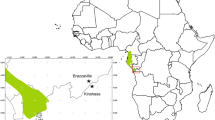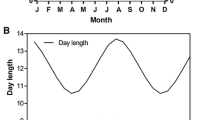Abstract
Information on the timing and dynamics of tree ring formation is essential to assess the seasonal behavior of secondary wood growth and its associated environmental influences. Araucaria angustifolia is a dominant species in highland pluvial ecosystems of southeastern South America. Previous investigations indicated that their growth rings are formed annually, but no information exists about the timing of growth ring formation and the environmental triggers influencing cambium activity. In this paper we examine inter- and intra-annual cambial activity in A. angustifolia, through anatomical and dendrochronological evidence at two study sites, and model the relationships between regional climate variation and intra-annual tree ring formation. The results confirm the annual growth ring formation in A. angustifolia and indicate that its growth season extends from October to April. Day length and temperature were the main environmental factors influencing the seasonal cambium activity. Our results evidence the dendrochronological potential of A. angustifolia for ecological and climatological studies in southeastern South America.





Similar content being viewed by others
References
Alves ES, Angyalossy-Alfonso V (2000) Ecological trends in the wood anatomy of some Brazilian species. 1. Growth rings and vesssels. IAWA J 21(1):3–30
Ash J (1983) Growth rings in Agathis robusta and Araucaria cunninghamii from tropical Australia. Aust J Bot 31:269–275. doi:10.1071/BT9830269
Backes A, Prates F, Viola MG (2005) Produção de serapilheira em Floresta Ombrófila Mista, em São Francisco de Paula, Rio Grande do Sul, Brasil. Acta Bot Bras 19(1):155–160. doi:10.1590/S0102-33062005000100015
Boninsegna JA, Villalba R, Amarilla L, Ocampo J (1989) Studies on tree rings, growth rates and age-size relationships of tropical tree species in Missiones, Argentina. AIWA Bull 10(2):161–169
Buckley B, Ogden J, Palmer J, Fowler A, Salinger J (2000) Dendroclimatic interpretation of tree-rings in Agathis australis (kauri). 1. Climate correlation functions and master chronology. J R Soc N Z 30(3):275–283
Callado CH, Neto SJS, Scarano FR, Costa CG (2001) Periodicity of growth rings in some flood-prone trees of Atlantic Rain Forest in Rio de Janeiro, Brazil. Trees (Berl) 15:492–497
Camargo AP (1978) Balanço hídrico no Estado de São Paulo. Instituto Agronômico, Campinas
Carvalho PER (2003) Espécies Arbóreas Brasileiras. Embrapa Informação Tecnológica, Brasília
Détienne P (1989) Appearance and periodicity of growth rings in some tropical woods. IAWA Bull 10(2):123–132
Devall MS, Parresol BR, Wright SJ (1995) Dendroecological analysis of Cordia alliodora, Pseudobombax septenatum and Annona spraguei in Central Panama. IAWA J 16(4):411–424
Dezzeo N, Worbes M, Ishii I, Herrera R (2003) Annual tree rings revealed by radiocarbon dating in seasonally flooded forest of the Mapire River, a tributary of the lower Orinoco River, Venezuela. Plant Ecol 168(1):165–175. doi:10.1023/A:1024417610776
Digby PGN, Kempton RA (1994) Multivariate analysis of ecological communities. Chapman and Hall, London
Duarte LS, Dos Santos MMG, Hartz SM, Pillar VD (2006) The role of nurse plants in Araucaria forest expansion over grassland in south Brazil. Austral Ecol 31:520–528. doi:10.1111/j.1442-9993.2006.01602.x
Dünisch O (2005) Influence of the El-niño southern oscillation on cambial growth of Cedrela fissilis Vell in tropical and subtropical Brazil. J Appl Bot Food Qual 79:5–11
Dünisch O, Ribeiro V, Montóia R, Bauch J (2003) Dendroecological investigations on Swietenia macrophylla King and Cedrela odorata L. (Meliaceae) in the central Amazon. Trees (Berl) 17:244–250
Enquist BJ, Leffler AJ (2001) Long-term tree ring chronologies from sympatric tropical dry-forest trees: individualistic responses to climatic variation. J Trop Ecol 17:41–60. doi:10.1017/S0266467401001031
Farjon A (2006) Araucaria angustifolia. In: IUCN. 2006 IUCN Red List of Threatened Species (online). http://www.iucnredlist.org
Fichtler E, Clark DA, Worbes M (2003) Age and long-term growth of trees in an old-growth tropical rain forest, based on analyses of tree rings and 14C. Biotropica 35(3):306–317
Fritts HC (1976) Tree rings and climate. Academic Press, London
Holmes RL (1983) Computer-assisted quality control in tree-ring dating and measurement. Tree-ring Bull 43:69–78
Hueck K (1972) As Florestas da América do Sul. Ed da Universidade de Brasília, Brasília
Jacoby GC (1989) Overview of tree-ring analysis in tropical regions. IAWA Bull 10(2):99–108
Klein RM (1960) O aspecto dinâmico do Pinheiro Brasileiro. Sellowia 12:17–48
Koch Z, Corrêa MC (2002) Araucária: a Floresta do Brasil Meridional. Olhar Brasileiro, Curitiba
Lisi CS, Pessenda LCR, Tomazello-Filho M, Rozanski K (2001) 14C Bomb effect in tree rings of tropical and subtropical species of Brazil. Tree-Ring Res 57(2):191–196
Lisi CS, Tomazello-Filho M, Botosso PC, Roig FA, Maria VRB, Ferreira-Fedele L et al (2008) Tree-ring formation, radial increment periodicity, and phenology of tree species from a seasonal semi-deciduous forest in southeast Brazil. IAWA J 29(2):189–207
Manly BFJ (1991) Randomization and Monte Carlo Methods in Biology. Chapman and Hall, London
Mariaux A (1967) Les cernes dans les bois tropicaux africains, nature et périodicité. B F Trop 113:3–14
Mariaux A (1981) Past efforts in measuring age and annual growth in tropical trees. In: Borman FH, Berlyn G (eds) Age and growth of tropical trees: new directions for research. Yale University, New Haven, pp 20–30
Marques MCN, Roper JJ, Salvalaggio APB (2004) Phenological patterns among plant life-forms in a subtropical forest in southern Brazil. Plant Ecol 173(2):203–213. doi:10.1023/B:VEGE.0000029325.85031.90
Morales MS, Villalba R, Grau HR, Paolini L (2004) Rainfall-controlled tree growth in high-elevation subtropical treelines. Ecology 85(11):3080–3089. doi:10.1890/04-0139
Nimer E (1989) Climatologia do Brasil, 2nd edn. IBGE, Rio de Janeiro
Paise G, Vieira EM (2005) Produção de frutos e distribuição espacial de angiospermas com frutos zoocóricos em uma Floresta Ombrófila Mista no Rio Grande do Sul, Brasil. Rev Bras Bot 28(3):615–625. doi:10.1590/S0100-84042005000300017
Pillar VD (2006) MULTIV. Multivariate Exploratory Analysis, Randomization Testing and Bootstrap Resampling. User’s Guide v. 2.4. Universidade Federal do Rio Grande do Sul, Porto Alegre (online). http://ecoqua.ecologia.ufrgs.br
Pillar VD, Orlóci L (1996) On randomization testing in vegetation science: multifactor comparison of relevé groups. J Veg Sci 7:585–592. doi:10.2307/3236308
Reitz R, Klein RM (1966) Araucariaceas Flora Ilustrada Catarinense. Herbário Barbosa Rodriguez, Itajaí
Roig FA (2000) Dendrocronología en los bosques del Neotrópico: revisión y prospección futura. In: Roig FA (ed) Dendrocronología em América Latina. EDIUNC, Mendoza, pp 307–355
Schöngart J, Piedade MTF, Ludwigshausen S, Hornas V, Worbes M (2002) Phenology and stem-growth periodicity of tree species in Amazonian floodplain forests. J Trop Ecol 18:581–597. doi:10.1017/S0266467402002389
Schulman E (1956) Dendroclimatic change in semiarid america. University of Arizona Press, Tucson
Schweingruber FH (1996) Tree rings and environment: dendroecology. Hall Haupt Publishers, Berne and Stuttgart
Seitz RA, Kanninen M (1989) Tree ring analysis of Araucaria angustifolia in Southern Brazil: preliminary results. IAWA Bull 10(2):170–174
Stahle D (1999) Useful strategies for the development of tropical tree-ring chronologies. AIWA J 20(3):249–253
Stahle DW, Mushove PT, Cleaveland MK, Roig F, Haynes GA (1999) Management implications of annual growth rings in Pterocarpus angolensis from Zimbabwe. For Ecol Manage 124:217–229. doi:10.1016/S0378-1127(99)00075-4
Stokes MA, Smiley TL (1968) An introduction to tree-ring dating. The University of Chicago Press, Chicago and London
Veloso HP, Rangel-Filho ALR, Lima JCA (1991) Classificação da Vegetação Brasileira Adaptada a um Sistema Universal. IBGE, Rio de Janeiro
Venugopal N, Liangkuwang MG (2007) Cambial activity and annual rhythm of xylem production of elephant apple tree (Dillenia indica Linn.) in relation to phenology and climatic factor growing in sub-tropical wet forest on northeast India. Trees (Berl) 21:101–110. doi:10.1007/s00468-006-0101-3
Vetter RE, Botosso PC (1989) Remarks on age and growth rate determination of Amazonian trees. IAWA J 10(2):133–145
Villalba R, Boninsegna JA, Holmes RL (1985) Cedrela angustifolia and Juglans australis: two new tropical species useful in dendrochronology. Tree Ring Bull 45:25–35
Worbes M (1988) Variety in structure of annual growth zones in Tabebuia barbarta (E. Mey) Sandw., Bignoniaceae, a tropical tree species from Central Amazonian inundation forests. Dendrochronologia 6:71–89
Worbes M (1989) Growth rings, increment and age in inundation forests, savannas and a mountain forest in the neotropics. IAWA J 10(2):109–122
Worbes M (1995) How to measure growth dynamics in tropical trees. IAWA J 16(4):337–351
Worbes M (1999) Annual growth rings, rainfall-dependent growth and long-term growth patterns of tropical trees from the Caparo Forest Reserve in Venezuela. J Ecol 87:391–403. doi:10.1046/j.1365-2745.1999.00361.x
Worbes M (2002) One hundred years of tree-ring research in the tropics—a brief history and an outlook to future challenges. Dendrochronologia 20(1–2):217–231. doi:10.1078/1125-7865-00018
Worbes M, Staschel R, Roloff A, Junk WJ (2003) Tree ring analysis reveals age structure, dynamics and wood production of a natural forest stand in Cameroon. For Ecol Manage 173:105–123. doi:10.1016/S0378-1127(01)00814-3
Yáñez-Espinosa L, Terrazas T, López-Mata (2006) Integrated analysis of tropical trees growth: a multivariate approach. Ann Bot (Lond) 98:637–645 doi:10.1093/aob/mcl142
Acknowledgments
The Inter-American Institute for Global Change Research (IAI, Grants SGP II 03SGP211-223 and CRNII 005) and Conselho Nacional de Pesquisa e Desenvolvimento Tecnológico (CNPq) provided research funding and scholarships to this project. Fundação de Amparo à Pesquisa do Estado do Rio Grande do Sul (FAPERGS) and Coordenação de Aperfeiçoamento de Pessoal de Nível Superior (CAPES) provided scholarships also. We thank Instituto Brasileiro do Meio Ambiente e dos Recursos Naturais Renováveis (IBAMA) and Pontifícia Universidade Católica do Rio Grande do Sul (PUCRS) for allowing field studies and facilities at FSP and CPM, respectively.
Author information
Authors and Affiliations
Corresponding author
Additional information
Communicated by S. W. Leavitt.
Rights and permissions
About this article
Cite this article
Oliveira, J.M., Santarosa, E., Pillar, V.D. et al. Seasonal cambium activity in the subtropical rain forest tree Araucaria angustifolia . Trees 23, 107–115 (2009). https://doi.org/10.1007/s00468-008-0259-y
Received:
Revised:
Accepted:
Published:
Issue Date:
DOI: https://doi.org/10.1007/s00468-008-0259-y




